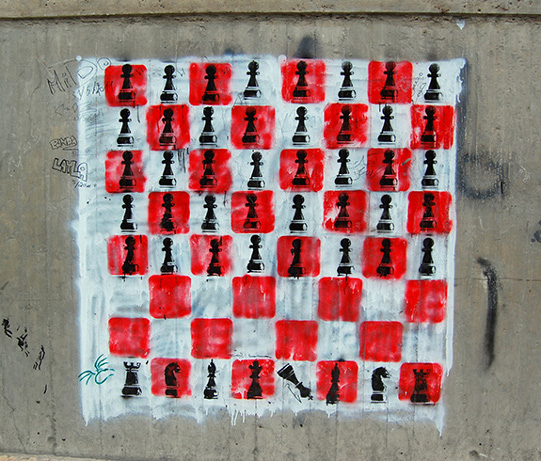
« PREVIOUS ENTRY
Why do we play video games, when they cause us such pain? On Jesper Juul’s “The Art of Failure”
NEXT ENTRY »
Probably true.

There’s a fascinating relationship emerging between graffiti and social media. Graffiti artists have always wrestled with their peculiar ephemerality of their form — as soon as a work goes up, you’re waiting for the authorities to take it down. It’s art made for a gallery that is often antagonistic to the artist. As a result, the explosion of cameraphones and picture-sharing online is producing a robust secondary audience: You can erase it the day it goes up, but the art lives on in the aether.
In Egypt, street art has flourished ever since Mubarak was toppled in 2011. Last month’s issue of Smithsonian included a short essay about the renaissance, and what caught my eye was how the Egyptian graffiti artists work to carefully document and promote their work online, intentionally blurring the line between which audience — online? offline? — the graffiti is for:
The graffiti has become a self-perpetuating movement. The images provoke the government, which responds with acts of cruelty that only increase the resolve of the artists. Much of the street art is covered over or defaced after it is created. That’s what prompted Soraya Morayef, a Cairo-based journalist, to photograph and document the images on her blog, “Suzee in the City.” She is an art critic as astute as those who survey the genteel galleries in New York and Paris.
“There are so many artists and styles,” Morayef says. “You can tell when someone has been influenced by Banksy or hip-hop fonts, but there are also a lot of individual styles using Arabic calligraphy and that have been inspired by Egyptian pop culture. There is Alaa Awad, who paints pharaonic temples and murals but with a modern twist to them. Then you have El Zeft and Nazeer, who plan their graffiti like social campaigns, where they pick a strategic location and write about it on social media and make short videos.”
Drop what you’re doing right now and go look at Morayef’s blog, by the way. She’s captured a spectacular range of street art in Egypt, and a lot of it is spellbinding in its beauty, political power, and, in the case of that fantastic chess-board piece I put up above, both. Obviously, the Egyptian postrevolutionary political situation is unbelievably messy right now, but that image — a fleet of pawns confronting the king — still fills the heart. The sheer range of styles in the Egyptian street-art scene is fascinating: It careens from Banksy-style stencil work to newspaper/op-ed cartoons to ancient Egyptian forms to traditional Bronx bubble lettering and back again.
Of course, the feedback loop between graffiti and street art isn’t necessarily so positive in all situations. Two weeks ago the New York Times wrote a piece about how graffiti tags are appearing in US national parks — including in remote, out-of-the way places like on cactuses out in the desert, which not only defaces the natural environment but can injure the plants, some of which are 150 years old. Why are people putting graffiti in such odd places? So they can post pictures on social media for bragging rights, the park officials argue. (They don’t offer any proof this is actually happening, but it seems like a reasonable explanation.)
In the case of Egypt, though, the feedback loop is powerful and useful. There’s no simple offramp to the political morass in the country, but art is a crucial way a culture thinks out through the problem, out loud.
(Oh, and: Desert cactuses can live to be 150 years old? Rad.)
I'm Clive Thompson, the author of Smarter Than You Think: How Technology is Changing Our Minds for the Better (Penguin Press). You can order the book now at Amazon, Barnes and Noble, Powells, Indiebound, or through your local bookstore! I'm also a contributing writer for the New York Times Magazine and a columnist for Wired magazine. Email is here or ping me via the antiquated form of AOL IM (pomeranian99).

ECHO
Erik Weissengruber
Vespaboy
Terri Senft
Tom Igoe
El Rey Del Art
Morgan Noel
Maura Johnston
Cori Eckert
Heather Gold
Andrew Hearst
Chris Allbritton
Bret Dawson
Michele Tepper
Sharyn November
Gail Jaitin
Barnaby Marshall
Frankly, I'd Rather Not
The Shifted Librarian
Ryan Bigge
Nick Denton
Howard Sherman's Nuggets
Serial Deviant
Ellen McDermott
Jeff Liu
Marc Kelsey
Chris Shieh
Iron Monkey
Diversions
Rob Toole
Donut Rock City
Ross Judson
Idle Words
J-Walk Blog
The Antic Muse
Tribblescape
Little Things
Jeff Heer
Abstract Dynamics
Snark Market
Plastic Bag
Sensory Impact
Incoming Signals
MemeFirst
MemoryCard
Majikthise
Ludonauts
Boing Boing
Slashdot
Atrios
Smart Mobs
Plastic
Ludology.org
The Feature
Gizmodo
game girl
Mindjack
Techdirt Wireless News
Corante Gaming blog
Corante Social Software blog
ECHO
SciTech Daily
Arts and Letters Daily
Textually.org
BlogPulse
Robots.net
Alan Reiter's Wireless Data Weblog
Brad DeLong
Viral Marketing Blog
Gameblogs
Slashdot Games